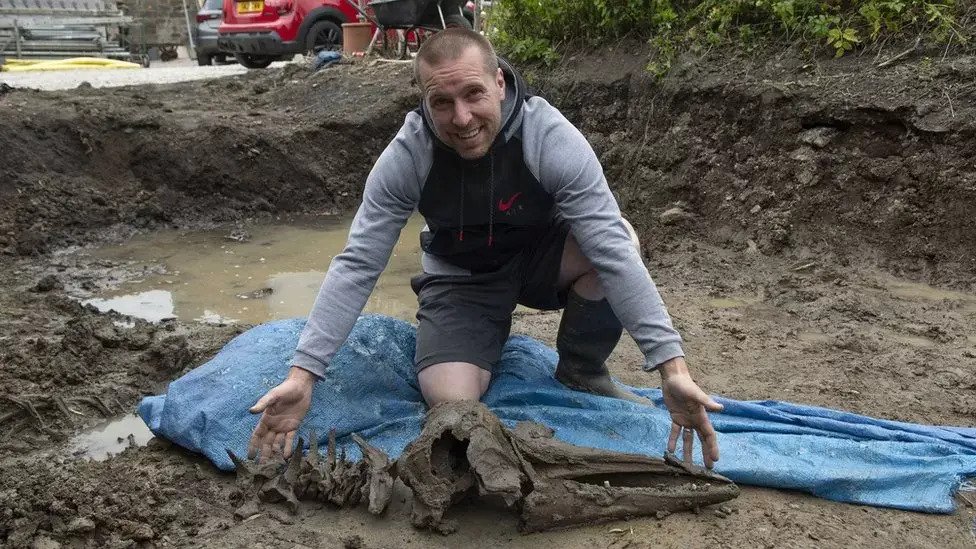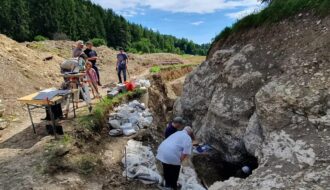Flipping Amazing! Father-of-four Discovers 8,000-Year-Old Dolphin Bones While Digging a Pool in His Back Garden
A man has discovered 8,000-year-old dolphin bones while digging in his back garden.

Paul McDonald, 44, was digging a swimming pool for his children when he struck a bone of the 10ft foot mammal with his digger.
The bottlenose dolphin is thought to have washed up on an ancient shoreline after the last Ice Age.
Archaeologists have described the prehistoric discovery in Causewayhead, Stirling, as “the find of a lifetime”.
The father-of-four said he recognised the dolphin’s skull by its long snout, rows of teeth and unmistakable shape.
The bones were preserved in clay, around 80cm below the current ground level, for what is thought to have been up to 8,000 years.
With them was a broken tool made from deer antler, which would have been used to carve the meat.
It is thought the dolphin was made into a meal by local hunter gatherers.
Mr McDonald, a medical rep in orthopaedics, who works with bones himself, said: “I was digging away in the swimming pool when I caught something unusual. I rolled it back and came down and pulled it out.

“I saw the roundness of the skull and then saw the snout and teeth and I knew right away it was a dolphin.
“I googled bottlenose and thought ‘wow’. Stuck in clay at that depth I knew it must be old. Now a tool has been found that tells us more about what was going on, it’s mind blowing.
“We bought the house six years ago and I’ve found a few interesting things, like old bottles and coins, but I’ve always wanted to find something like this.”
The skull has been removed by experts from the National Museums Scotland (NMS) so it can be analysed, while the rest of the skeleton will be fully excavated.
Stirling archaeologist Dr Murray Cook said the discovery could be the first of its kind in Scotland in over a century.
The last whale bones found near Stirling were in 1897 but there are no recent records of dolphin discoveries.
Dr Cook said: “It is the find of a lifetime. I don’t think one of these has ever been subject to modern excavation.
“After the Ice Age, following the retreat of the ice, this area was a vast inland sea teeming with life.
“Our earliest ancestors would have been walking the shoreline every day for food such as seaweed and shellfish and if a seal, a whale or a dolphin washed up it would be carved into almost immediately.
“The tool made from antler tine means that they were hacking into the dolphin and that’s tremendously exciting. The tip has broken off – we still hope to find it – and they’ve discarded it.”
Andrew Kitchener, principal curator of vertebrates at NMS, said: “I’ve been at the museum for 35 years and this is the first time something has emerged from the clay like this. It is a really interesting and important find.
“It seems like it’s a stranded animal that’s just sunk into the clay and been preserved all this time until Paul uncovered it, which is kind of a miracle really.”

Mr Kitchener said there was lots of analysis to be done, but after they get the bones radiocarbon dated, they can work out the age.
“It’s fairly small so possibly a female, and its teeth are fairly worn which suggests it’s an older animal.
“We’re only at the beginning. It’s just exciting to see it emerging from the clay.”
The bones in isolation are owned by Mr McDonald, but the antler tool could be declared Treasure Trove, which may mean he could win a reward as the finder.
He said: “I’m just happy to find it and make sure it’s looked after and people get to see it.”
Ancient Archaeology




